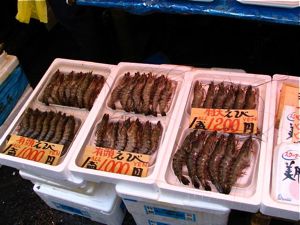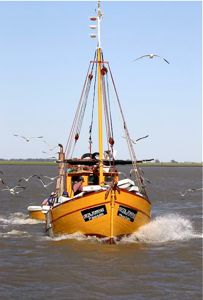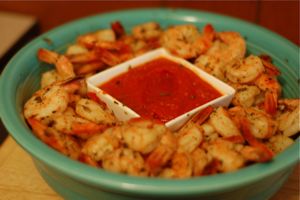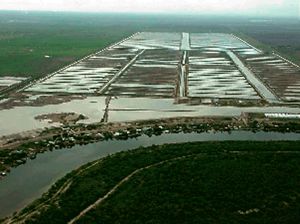Ed's Party Shrimp
• I filled a stock pot with water and about enough salt for it to taste like the sea (about 1/2 to 3/4 cup).
• I added about 3 cups of dry vermouth. (It's what I had left over after a night of martinis).
• I then threw in one tin of the fish rub that I found in the spice rack at the grocery store. If you are morally opposed to using pre-packaged fish rub then I suppose you could substitute with about 1/2 cup of the following chopped/ground and combined: rosemary, thyme, sage, marjoram, parsley, onion, garlic, pepper, celery seed, oregano, basil (basically a mystery basket of cupboard spices)
• I quartered 2 lemons, squeezed the juice into the broth..and then threw in the rinds too.
• Here's the secret.....two sticks of butter (sshhh!). Just throw it in too.
• Bring to a boil...then simmer for 15 minutes.
• I used frozen shrimp. Cook the shrimp in the simmering liquid in small batches for about 3 minutes each.
Voila! Yummy...BUTTERY shrimp!

THE DARKER SIDE OF SHRIMP
As someone raised happily on my mother's spring rolls, black pepper shrimp, caramelized shrimp, shrimp dumpling soup, shrimp fried rice, and just plain ol' spicy stir-fried shrimp, giving them up has been one of the most difficult diet changes I've tried to make. They're so succulent and versatile and easy to cook. And they're everywhere -- which is, unfortunately part of the problem.
It was during one of my early trips back to Vietnam that I first realized the devastating effect on my homeland as rice farmers and fishermen moved to the lucrative, fast, easy promises of shrimp farming. I could hardly blame war-torn, embargo-crippled families for trying to make a living. Through the 90s, though, shrimp and prawns became a standard item on every restaurant menu, and as Southeast Asian food became popular, so did one of its staples. Jumbo shrimp became gourmet rather than simply an oxymoronic joke. They became affordable and, for the home cook, approachable.
However, that popularity came at a steep price. Nearly 40 percent of the world's mangroves, crucial to the health of the oceans, has been destroyed because of shrimp farming along coastal areas. In Thailand, it takes roughly three years for a shrimp farm to ruin the local ecosystem; many farms simply pick up operations and move further along the coast, hopscotching until there's no clean coast available.
Inland ponds require heavy use of chemicals to clean the water and kill the viral invasions endemic to intensive farming. The European Union bars all shrimp from China, where carcinogenic chemicals appears frequently in farmed shrimp; the U.S. still imports it.
Another heavy impact comes hidden in the shrimp's feed: while in the wild they scavenge, on farms they're fed fish much higher on the food chain.
THE SILVER LINING
Fortunately, there's a tiny tiny bit of light for shrimp lovers.
The strongest among us have already become vegetarians, but for others like me, with weaker wills tied more directly to emotional and sensual cravings, searching out good shrimp is possible.
The Monterey Bay Aquarium's Seafood Watch lists a few options for those who still crave a taste of shrimp now and then. Currently best on the list are wild-caught prawns and spot shrimp from British Columbia, and wild-caught ocean or cocktail shrimp from Oregon. Small, cold-water shrimp are the most sustainable. True, they're not as sexy as those big, lusty, warm-water prawns. However, anyone even remotely worried about the future of our planet should avoid these oversized, striped crustaceans.
Wild-caught is no guarantee, as by-catch is always a problem, but look for those from domestic companies. Small pink or white shrimp are generally -- very generally -- a safer bet for the conscientious eater than large, brown, imported shrimp.
Sustainable shrimp farming is still in its infancy. That said, Ecuador has surpassed other countries in developing organic, nonpolluting shrimp farms. EcoFish imports it under the name "Henry & Lisa's Natural Shrimp." Look for their bags of cooked or raw shrimp in the freezer section of naturally-minded, full-service markets.
I was dreading lunar new year without my family's recipe for spring rolls. The tofu version is fine the rest of the year, but it never inspires me to heights of celebration. So, I'm very glad to know that, come February, I'll be able to make my mom's cha gio.

MORE INFO
Some links for those interested in learning more:
• NASA's Earth Observatory shows before and after Landsat images of shrimp farming effects along the Pacific Coast of Honduras, one of the largest importers of the crustaceans to the U.S.
• The Environmental Justice Foundation created a short film about shrimp farming along the eastern coast of Brazil.
• Shrimp News International offers a detailed description of shrimp farming. Food wonks immune to industry spin might like scrolling down to see the charts and illustrations showing the life cycle of shrimp (missionary position!) or how El Nino affects the supply of larvae . Be forewarned: the text is a strong reminder that shrimp are, after all, just swimming insects.
• The Chefs Collaborative's communique with recommendations for sustainable shrimp was directed at restaurants, but the home cook can also use their excellent information.
• The White Boot Brigade, based in New Orleans, is a nonprofit dedicated to developing a sustainable shrimp industry in Louisiana. They work to educate businesses and consumers about the economic, environmental and social benefits of supporting small family fleets that harvest shrimp from the Gulf.
• And, finally, what's the difference between a shrimp and a prawn? In the U.S., nothing. Though there's sometimes a vague sense of "specialness" about prawns, the two words appear in menus and markets interchangeably. Australians, however, apparently make a point of remembering that prawns have evenly overlapping abdominal segments and that their females release eggs to currents rather than brooding them. For them, Americans are silly and confusing for calling shrimp prawns and vice versa.



